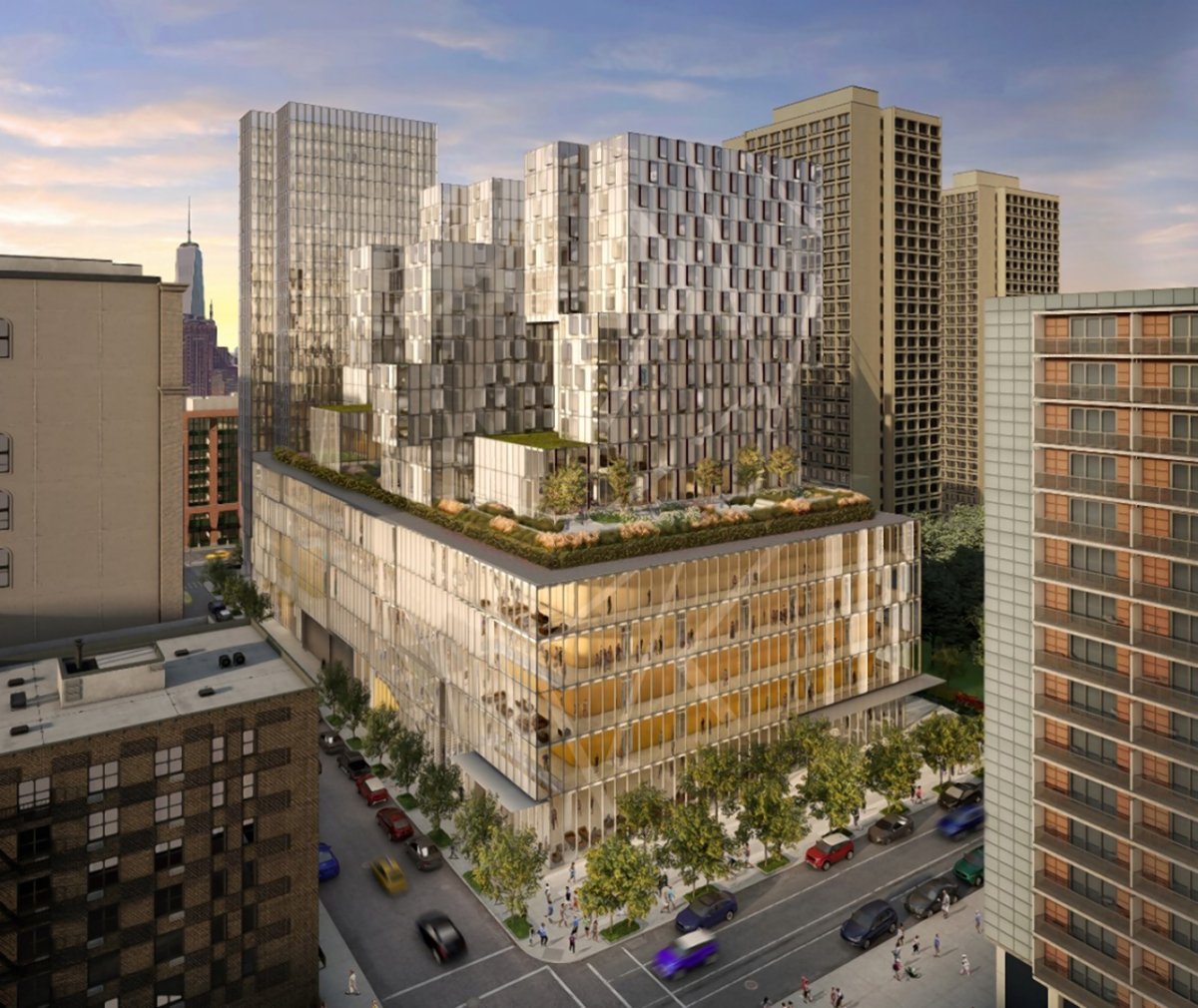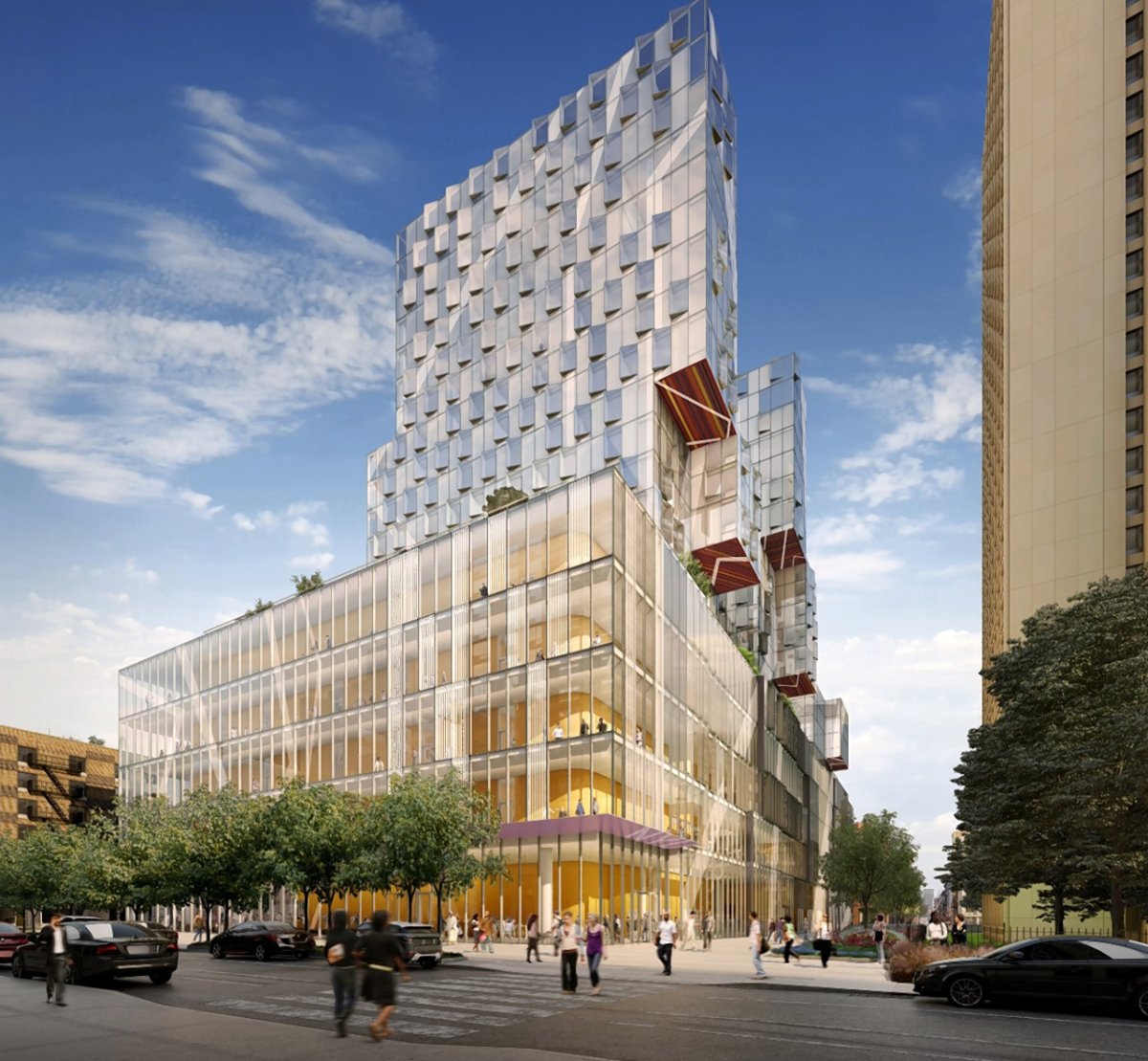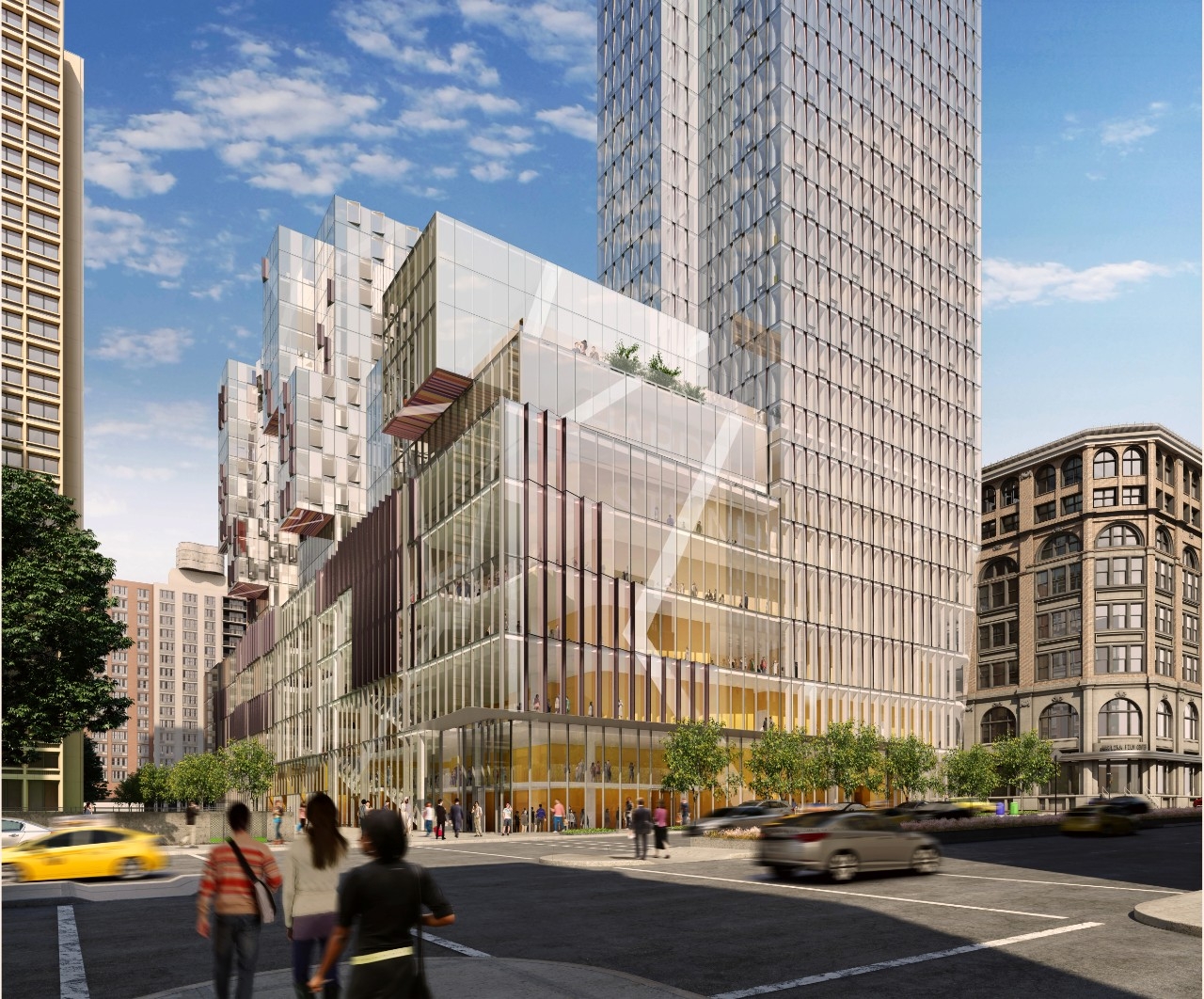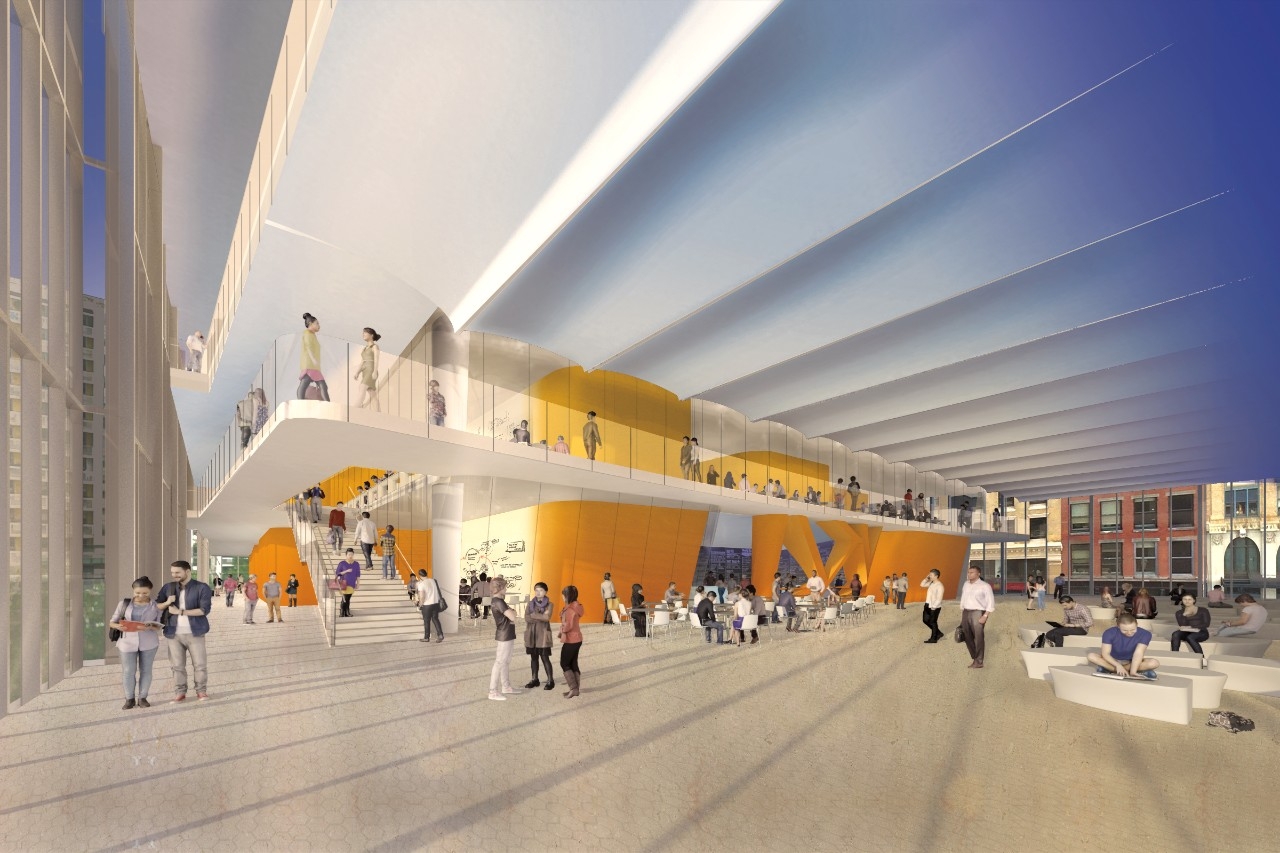BY DENNIS LYNCH | New York University unveiled renderings last week of its multipurpose 181 Mercer building that show a sleek, modern glass-encased facility with tons of open space (inside), athletic facilities, classrooms and dorm rooms. The $128 million building will be N.Y.U.’s largest educational facility and is set to open by late 2021 as part of the university’s massive “N.Y.U. 2031” 25-year redevelopment plan.
N.Y.U. revealed the designs at the Dec. 8 meeting of its University Senate.
The project was formerly known by the more quirky name of the “Zipper Building,” due to its zigzag appearance when viewed from overhead. However, most people — at least those not hovering in helicopters — will be looking up at it — way, way up. The educational edifice will rise 300 feet at its tallest point.

The 735,000-square-foot building has three main parts. The block-long lower section — stretching from W. Houston St. to Bleecker St. along Mercer St. — houses classrooms, theaters, studios, common space and other facilities. A six-lane swimming pool and a four-basketball-court gym are located on the basement level. Above this base, students will live in dorms in a tower, and faculty will have housing in an even taller tower on the building’s Houston St. end.
The building was designed to be green and N.Y.U. will seek the most modern LEED (Leadership in Energy and Environmental Design) certification available, LEED v4. The 181 Mercer building replaces the now mostly demolished Coles Sports Center building, which was a low-rise gym only.
The design for the new building was vehemently opposed by some locals because of its size and design, which many said was out of context with the neighborhood. The site is surrounded on three sides by historic districts or individual landmark buildings. Community Board 2 recommended to deny the entire N.Y.U. expansion plan.
N.Y.U. says the building offers a new “gateway” to the south. But Soho is the neighborhood to the south, and Sean Sweeney, director of the Soho Alliance community organization, called the building “atrocious.”
“A well-designed glass building could fit into a historic district,” he said. “This is not a well-designed building. The massing is atrocious and does nothing for the neighborhood except to create high-rise towers to give students a better view of the city. It doesn’t add — it only detracts from the historic districts and the landmarks around it.”

Sweeney added that he worried that more student housing would only make the area surrounding it more crowded and spur more applications for bar liquor licenses — which the neighborhood has fought off in many cases over the years — to cater to students there.
A phalanx of local neighborhood associations and preservation groups sued over the larger “N.Y.U. 2031” redevelopment plan, but the state’s highest court O.K.’d the plan last year. Assemblymember Deborah Glick, a party to the lawsuit, said the design reveal bowled her over.
“They confirmed our worst fears of a massively obstructive and out-of-context building,” she said of the design. “It is so inappropriate, it is shocking.”
Many, including Community Board 2 Chairperson Terri Cude, also lament the loss of community green space outside the former Coles building.
“The 181 Mercer building will sit on land that was formerly the community’s,” Cude said, “the previously city-owned land in front of Coles gym that had a children’s playground, reflecting pool and the now-relocated dog run — plus much of the footprint of Coles gym that was itself built on former open space. It is frustrating that we so often have to fight to keep green open spaces that are an essential part of healthy living,” Cude said.
The project includes N.Y.U.’s purchase from the city of the open-space “strip” along Mercer St. that was a leftover from a failed Robert Moses highway plan and which formerly contained the playground and Mercer-Houston Dog Run.

The final building is slimmer and 20 percent smaller than what was originally allowed by the city. But that’s little consolation to the project’s numerous critics. The Greenwich Village Society for Historic Preservation blasted the newly unveiled 181 Mercer design.
“The design is atrocious, and the complex will completely overwhelm the area,” said Andrew Berman, the society’s director. “N.Y.U. claims the new design promotes ‘transparency’ and ‘connectivity’ between the university and surrounding community. That’s lipstick on a pig. A 300-foot-tall glass building is not transparent and is not going to feel contextual with the surrounding community.”
Berman agreed with the analogy that the almost sci-fi-style building’s appearance in the historic Village would be like a “Close Encounters” experience — like a huge spaceship plopping down here.
“I think it’s going to be a completely alien presence,” he said.
He added that the building’s size was only cut down due to opposition.
Despite the torrent of community criticism, though, Andrew Hamilton, N.Y.U.’s new president, said the university greatly needs the gargantuan facility.
“It is difficult to think of another school with a more acute need for academic space than N.Y.U.,” Hamilton wrote to the school community.
The building “will add nearly 60 new classrooms,” he said. “It will at long last give young performing-arts students in the Tisch and Steinhardt schools practice, rehearsal and performance spaces that are in line with the caliber of their programs. It will give our campus a modern gym to serve our student/athletes and the fitness needs of the rest of us. It will provide much-needed housing for both students and faculty.”
John Beckman, the university’s spokesperson, in a statement to The Villager, said, “One has to allow for subjective reactions to any building design,” but that there were a number of reasons for 181 Mercer’s design. Its transparency contrasts completely with the uninspiring design of the Coles gym and will lighten the streetscape, he noted. Because this transparency will let in sun, it will reduce energy usage, he said.
“We heard repeatedly from the community how important it is for our buildings to engage and activate the streets around them,” he added.

In terms of whether the building is contextual with the surrounding neighborhood, he stressed there is no unifying architectural vernacular to draw from.
“In its contemporary way, the design for 181 Mercer is about neither mimicry nor opposition to its context, but harmony,” he said.
The new building will also include an airy public atrium and a community room. Community Board 2 residents will be able to buy 12-use passes to use N.Y.U.’s new 404 Fitness facility, at 404 Lafayette St., as well as the athletic facilities at 181 Mercer just as they could for use of the Coles facilities, a university spokesperson said.
The university expects to complete demolition of the Coles building by this coming February. The next phase of demolition will be the removal of the old building’s girders and will require a crane at the site.





























